Written by: Will Awang
Consumers’ cross-border payment habits are constantly changing: people are trying a variety of payment methods, but are still looking for better options. As VISA Ryan McInerney said: “In the past five years, payment methods have changed more than in the past 50 years.”
Today, with the continuous development of blockchain technology and digital currency, the deeper changes behind the payment methods are actually changes in the accounting methods - blockchain, an open and transparent global public ledger.
The way humans keep accounts has changed only three times in thousands of years, each of which has profoundly shaped the economic form and social structure, and each breakthrough has reflected the co-evolution of technology and civilization.
- The single-entry bookkeeping of the Sumerian period enabled humans to break through the limitations of oral communication for the first time, facilitating the formation of early trade and states.
- Double-entry bookkeeping played a role in promoting the commercial revolution during the Renaissance, which led to the emergence of banks and multinational corporations and the establishment of commercial credit.
- The distributed accounting promoted by Bitcoin in 2009 has led to decentralized finance, changes in trust mechanisms, and the rise of digital currencies.
This far-reaching change will not happen overnight, but is constantly evolving. It has also led to Web3 payments based on blockchain and digital currency. This new payment method is constantly penetrating into all aspects of real society.
Therefore, this article uses the consumer cross-border payment survey report recently released by VISA and uses cases in the market to propose solutions for the main scenarios of current consumer cross-border payments using Web3 payments, and finally sees where the future of Web3 payments will be.
The full text is 15,000 words. Enjoy as follows:
1. The growing cross-border payment market
Driven by the surge in cross-border e-commerce, cross-border travel and cross-border remittances, the cross-border payment market is experiencing explosive growth. Consumers are making cross-border payments more frequently than ever before, and the Bank of England predicts that by 2027, payments related to cross-border payments will reach $250 trillion.
Consumers around the world are embracing cross-border payments, and today consumers are spending more on cross-border transactions than ever before, but what’s really interesting is the frequency. 30% of people shop online through cross-border e-commerce every week, 45% send and receive remittances every month, and 66% travel abroad every year.
Typically, people form habits that make routine decisions easier and more efficient, but in the area of cross-border payments, these habits have not yet been formed. On average, they use 4 out of 7 different payment methods, and only 16% of consumers always use the default payment method.
At present, it seems that no payment method can fully meet consumers' demand for cross-border payments, although nearly 80% of consumers still use traditional banks for cross-border payments. But consumers are very clear that they need a safe and trustworthy cross-border payment provider.
A total of 771 million people will make cross-border transactions between June 2023 and June 2024. VISA’s research shows that this growth is driven by three transaction categories: e-commerce, travel and remittances.
1.1 Main scenarios and methods
A. Cross-border e-commerce
Eight out of ten consumers choose to shop through cross-border e-commerce, and 67% of them make cross-border purchases every month. According to the report "Global Trends in B2C E-commerce and Online Payment Innovation in 2024", the global B2C e-commerce market is expected to exceed US$8.3 trillion by 2026. Today, it is no longer difficult to find the desired products around the world, but the convenient payment experience still needs to be improved. Consumers are eager to obtain simple, easy-to-use, safe and reliable payment methods to successfully complete every cross-border shopping.
B. Cross-border travel
Two out of three people travel internationally, and 52% of them travel more than once a year. According to the 2024 travel trends, the biggest purpose of people traveling is to relax and relieve stress. Therefore, the last thing travelers want to experience is stress or worry when shopping. They need a simple and secure payment method so that they can fully enjoy their travels.
C. Cross-border remittances
Four out of ten people use cross-border remittance services, and 45% of them make remittances every month. Despite the complex geopolitical situation, the number of international migrants continues to grow, and the cross-border remittance market is expected to exceed US$1 trillion by 2028. This trend has also driven the increasing demand for people to send money to their relatives and friends at home. Consumers are in urgent need of a safe and reliable way to transfer money across borders.
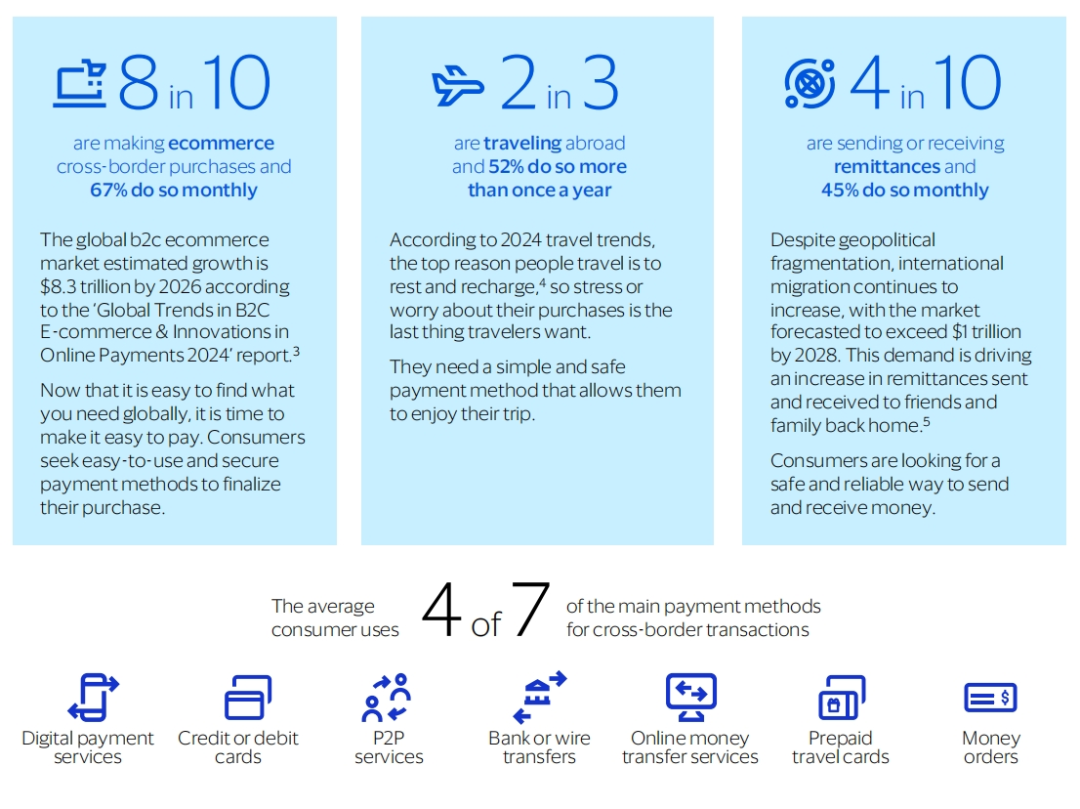
(Unlock the opportunity in cross-border payments, VISA)
Of the following seven cross-border payment methods, the average consumer uses four:
- Electronic payment methods;
- Credit or debit card;
- P2P transfers;
- Bank transfer
- Online transfer;
- Prepaid traveler's checks/cards;
- cash.
1.2 Why now is the right time to offer cross-border services to consumers
The cross-border transaction market is large and growing. This is a critical stage in the development of cross-border transactions. More and more consumers are making cross-border payments frequently, but traditionally these transactions have been slow, costly and lack transparency. However, all this can change.
Consumers currently use multiple payment methods. Each consumer is trying a variety of different payment solutions, actively seeking the best one for them. But they haven’t found the ideal one yet. They crave more choice and want guidance to help them make informed decisions. As consumers begin to form habits that may last a lifetime, now is a critical time to influence their choices.
Consumers need stable payment habits and reliable partners. As banks and fintech companies realize the potential of becoming consumers' preferred cross-border payment method, market competition will intensify. This is not only an opportunity to attract new customers through new services, but also an opportunity to retain existing customers' cross-border consumption through a one-stop solution. But at the same time, there is a risk that other competitors will get ahead of them.
The foundation of trust cannot be ignored. Trust, security and reliability are crucial in cross-border transactions, especially when the transaction amounts are often large. Consumers are very sensitive to these factors and expect banks and fintech companies to provide a safe and reliable payment environment. Earning the trust of customers is key to building long-term relationships.
II. Main Scenarios and Models of Consumer Cross-border Payments
The following will explore in depth the scenario processes of cross-border e-commerce, cross-border travel and cross-border remittance payment transactions, as well as the core issues encountered in cross-border payments.
2.1 Cross-border e-commerce
In the past year, about 589 million people around the world participated in cross-border e-commerce transactions. Among them, 72% of transactions were for the purchase of physical goods through mainstream online retailers such as Amazon and eBay, and 44% of transactions were for the purchase of digital products. Although the social media market is on the rise, only 30% of consumers shop through these platforms, which may be related to concerns about data leakage.
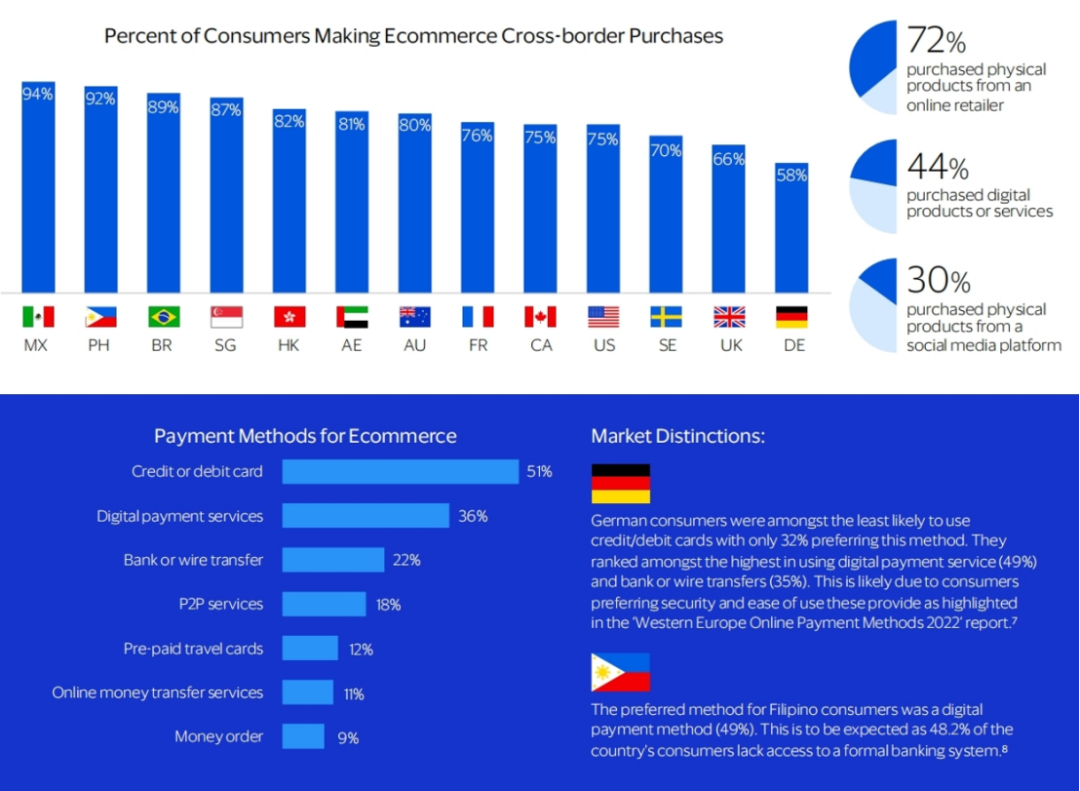
(Unlock the opportunity in cross-border payments, VISA)
When it comes to payment methods for cross-border shopping, consumers mostly choose credit cards, debit cards or digital APP payment services (such as Paypal, Apple Pay). However, financial institutions may be surprised to find that only 51% of consumers use credit cards or debit cards. This means there is still market space for other payment methods, such as 36% of consumers choosing digital APP payment services, and some consumers using wire transfers or P2P services.
However, there are still significant differences in consumption habits between different countries:
Germany: Consumers are least willing to use credit or debit cards (only 32%), preferring digital app payment services (49%) and bank transfers or wire transfers (35%). This may be because consumers place greater emphasis on payment security and ease of use, as highlighted in the report "Online Payment Methods in Western Europe 2022".
Philippines: Consumers prefer digital APP payment methods (49%), which may be related to the fact that 48.2% of local consumers cannot access the traditional banking system.
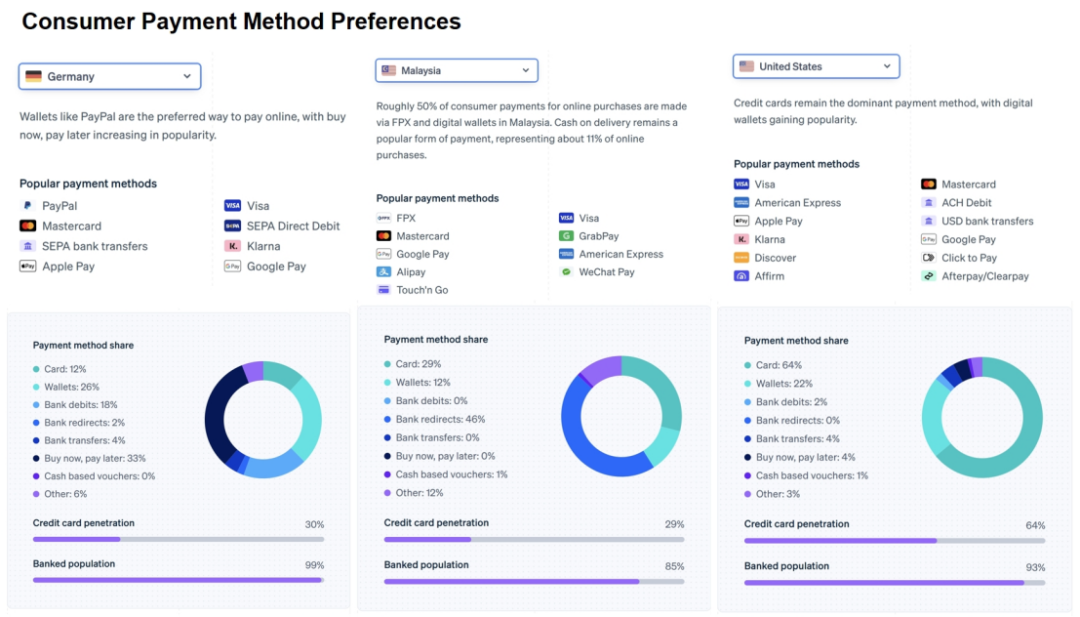
(Convert more customers with the most relevant payment methods, Stripe)
The above picture shows the payment habits of consumers in Germany, Malaysia, and the United States, using Stripe's Payment Method dashboard. These data show that the choice of payment method varies by region and consumer demand, and financial institutions and e-commerce platforms need to provide diversified payment solutions based on local market characteristics.
The payment scenario of cross-border e-commerce is more likely to be that consumers in their own country make consumption payments through the payment gateway of overseas e-commerce platforms. The payment gateway will inevitably link many payment methods, such as the preferred credit or debit card (through the card organization network), such as Paypal, Apple Pay (through digital app payment), such as bank transfer (through the bank's SWIFT network), etc.
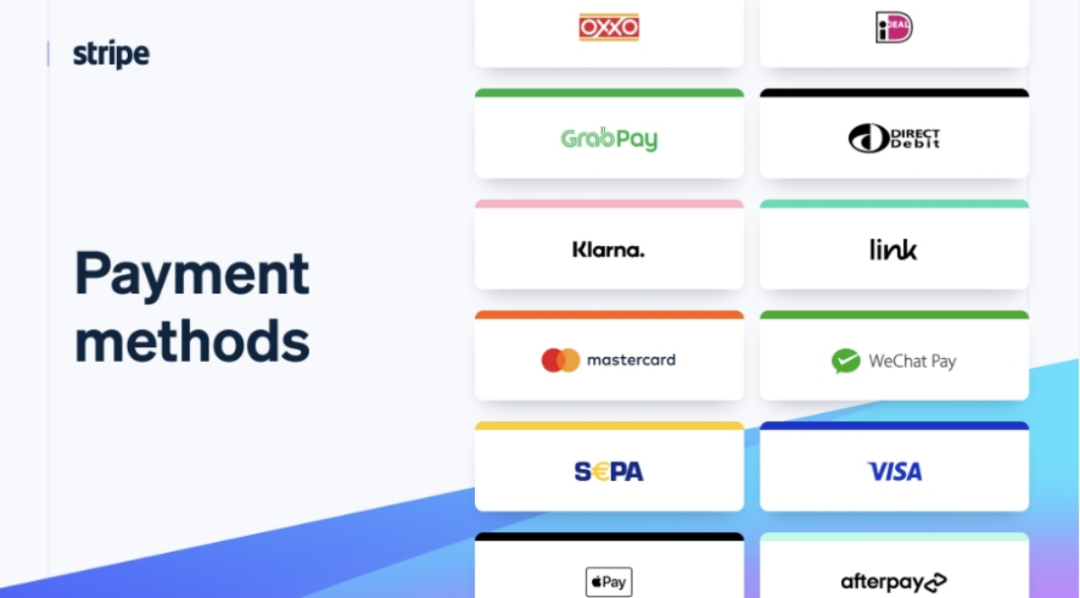
(Convert more customers with the most relevant payment methods, Stripe)
2.2 Cross-border travel
Two-thirds of consumers surveyed have traveled internationally in the past year, with 62% saying they used a credit or debit card to book their travel, making it the most popular payment method. This preference is reflected not only when booking travel, but also in their actual spending abroad. Most respondents use the same payment method during their travel as when booking their travel. This is likely because credit cards are widely accepted and offer conveniences such as instant currency conversion and fraud protection.
Despite geopolitical factors, cross-border travel remains the norm, especially in Singapore (86%) and the UAE (84%), where consumers have the highest proportion of international travel. In each of the 13 markets surveyed, nearly 50% of respondents have traveled abroad in the past year.
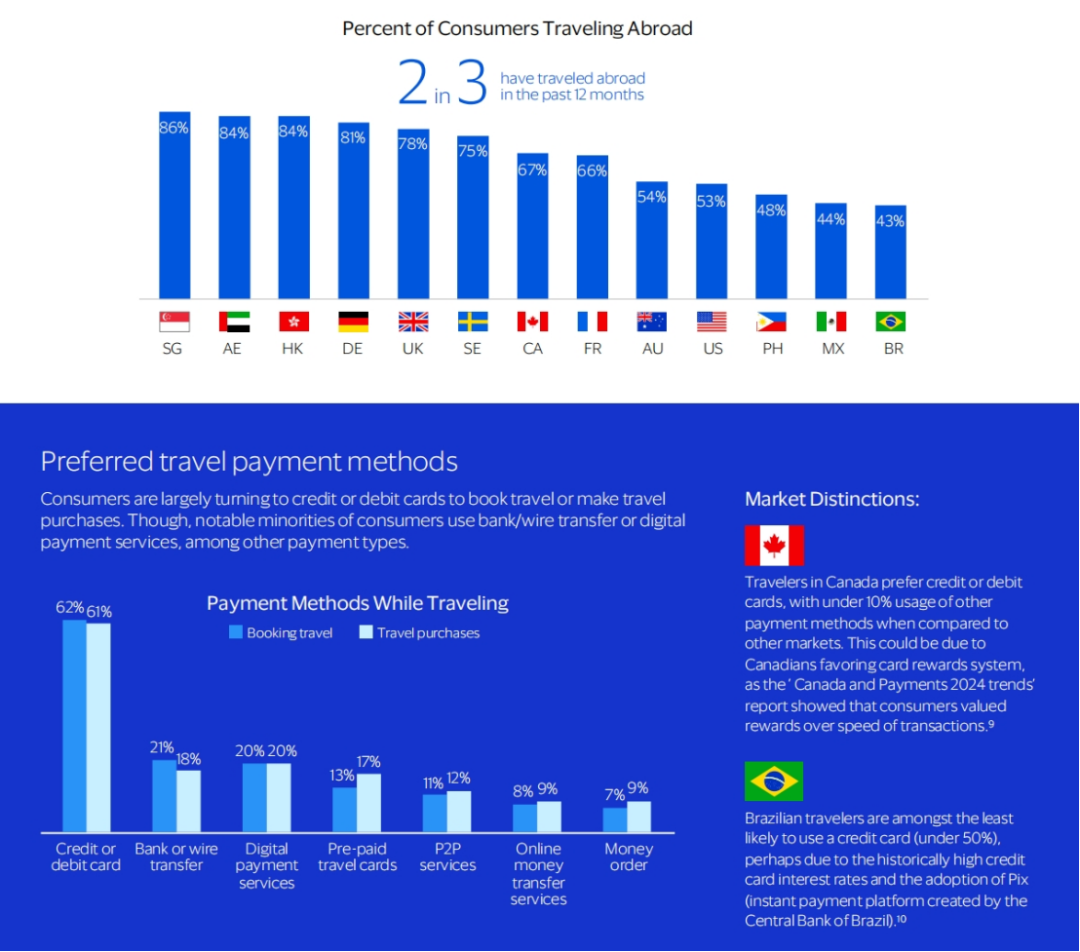
(Unlock the opportunity in cross-border payments, VISA)
In terms of travel payment methods, consumers mostly choose credit or debit cards to book or pay for travel. However, a small number of consumers use other payment methods such as bank transfers, wire transfers or digital APP payment services.
Canadian travelers are particularly fond of credit or debit cards, with less than 10% using other payment methods compared to other markets. This may be because Canadians place a higher value on credit card rewards systems, with consumers placing more emphasis on reward points than transaction speed, according to the Canadian Payments Trends 2024 report.
In contrast, Brazilian tourists are the least likely to use a credit card (less than 50%), which may be related to Brazil’s historically high credit card interest rates, but also to the widespread adoption of PIX, an instant payment platform created by the Central Bank of Brazil.
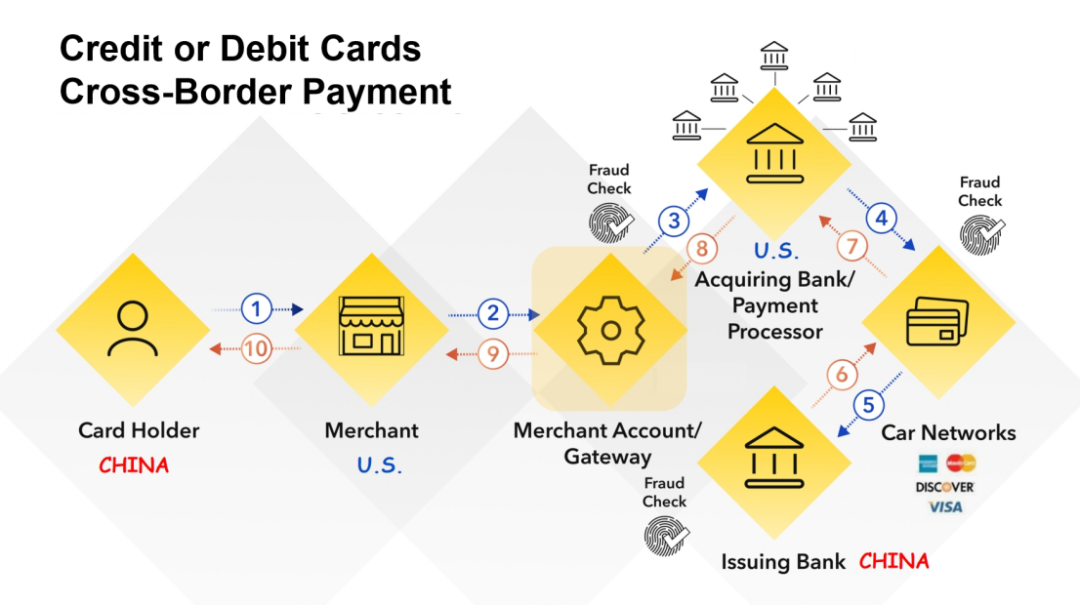
(Understanding Cross-Border Payments: Process, Challenges, and Solutions)
The payment scenarios are more likely to be: consumers use their own debit or credit cards to pay at offline overseas merchants, or scan codes through digital APP payment platforms. The above figure shows the process of debit or credit card payment.
2.3 Cross-border remittances
40% of respondents have sent or received remittances in the past 12 months, with bank transfers or wire transfers being the most common payment methods. Not surprisingly, countries with large migrant workforces, such as the UAE and the Philippines, have the highest rates of remittances sent and received, at 87% and 74% respectively. Remittances are an important source of funds for millions of workers and families around the world, and remitters want the most cost-effective payment services for each transaction.
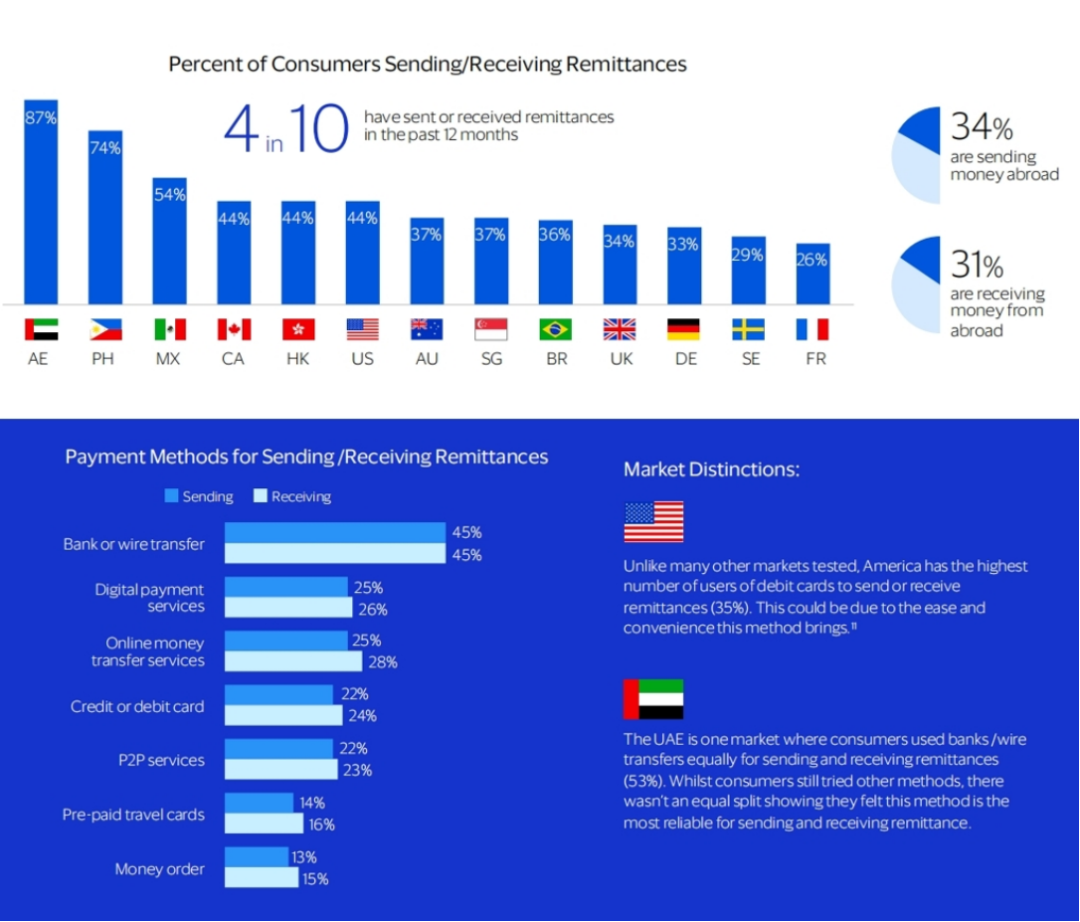
(Unlock the opportunity in cross-border payments, VISA)
In 2023, the total amount of remittances to low- and middle-income countries increased by 3.8% to US$669 billion. In the Asia-Pacific region, China, India and Singapore are markets with more frequent remittance activities. A notable trend is that digital app payments are becoming more and more popular among remittance parties due to their security and ease of use, and are gradually becoming the main way to send and receive remittances. Compared with traditional remittance methods, digital app payments are considered to be more secure.
There are significant differences in cross-border remittance payment methods compared to digital app payment methods. Although bank or wire transfers have longer processing times and are often more expensive, they are still the most commonly used remittance methods.
Unlike other markets, the United States has the highest percentage of users using cross-border remittances (35%). This may be due to the convenience and ease of use of debit card payment methods. In the UAE, consumers use bank or wire transfers at similar rates when sending money across borders (both 53%). Although consumers have also tried other payment methods, bank or wire transfers are the most reliable methods for cross-border remittances.
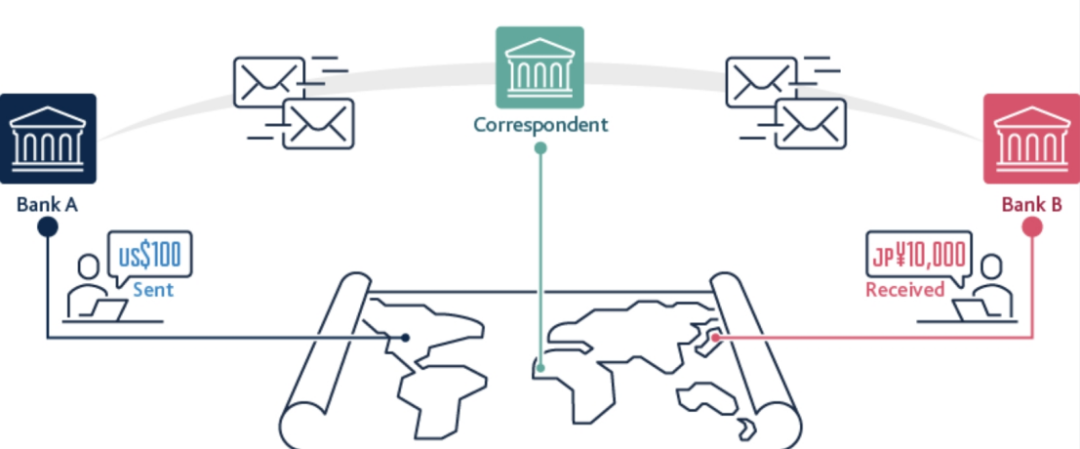
(Cross-border payments, Bank of England)
The above is a flow chart of cross-border remittances through a banking network. If the big banks in developed countries have settlement accounts with each other, the transaction process will be relatively simple. However, not every bank has a direct relationship with each other, so sometimes they need to conduct transactions through an intermediary - a "correspondent bank". If there is no direct relationship between bank A and bank B, the correspondent bank will provide them with an account.
For countries with small currencies or limited foreign exchange reserves, the agency banking model (middlemen earning the difference) will greatly erode their profits and bring huge burdens to consumers. According to statistics from international banks, the average cost of remittances worldwide accounts for 6.62% of the remittance amount.
Research shows that consumers expect cross-border payments to be as convenient and smooth as daily payments, and financial institutions must work hard to meet this demand. Customers want cross-border payments to be fast, transparent and efficient, with instant payment and no days of waiting for settlement, especially for small transactions.
3. Characteristics and pain points of cross-border payments
3.1 Cross-border payments are becoming more common and frequent
According to VISA's research, cross-border payments are common among many consumers in all regions. However, what may surprise many people is how frequently these cross-border purchases occur. Although there are differences between different types of goods and different markets, overall, a considerable number of consumers make cross-border payments monthly, weekly or even more frequently.
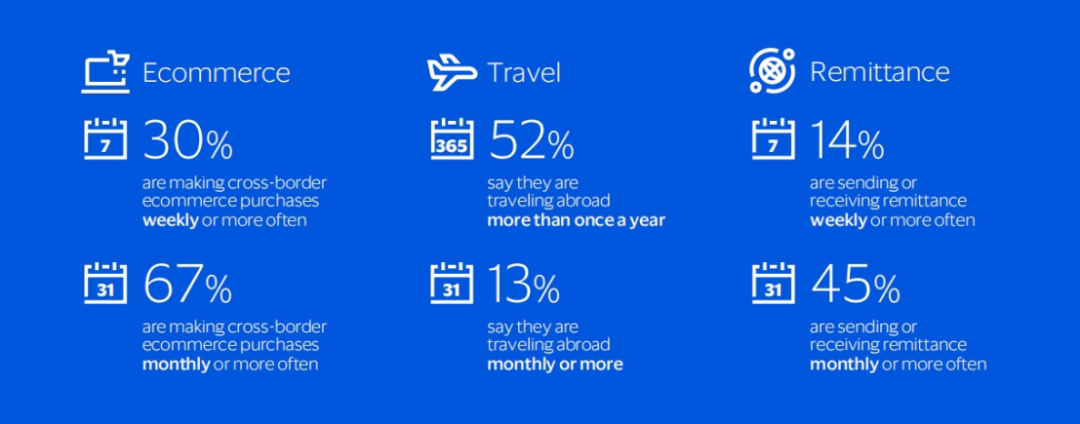
(Unlock the opportunity in cross-border payments, VISA)
Most digital natives (i.e., those who grew up in a digital environment) - Gen Z (84%) and millennials (83%) - have made a cross-border transaction in the past month, which is a considerable number. So what about baby boomers and older groups? In fact, 68% of them said they had made a cross-border transaction in the past month. They are catching up - in addition to purchasing goods and services, they may also send money to family members abroad, pay for school fees, or purchase real estate.
3.2 Payment methods are not fixed and habits have not yet been formed
Cross-border payments are becoming more common and frequent, and it is important to understand how they handle these transactions. VISA research shows that consumers have not yet formed a clear preference for payment methods for cross-border consumption and services. This is the window period for fintech companies to provide cross-border payment services.
Currently, consumers still use a variety of different applications and payment methods when conducting cross-border transactions. In terms of cross-border e-commerce and cross-border travel, more than 50% of consumers use credit or debit cards through traditional banks to pay, which is obviously the most commonly used payment method, but not the only option. Similarly, digital app payment services are also popular, but other payment methods also account for a considerable proportion of the remaining consumption.
When sending money across borders, consumers are choosing a wider range of payment methods. Bank transfers or wire transfers are the most widely used methods, but many consumers also use digital online transfer services, credit or debit cards, and P2P services.
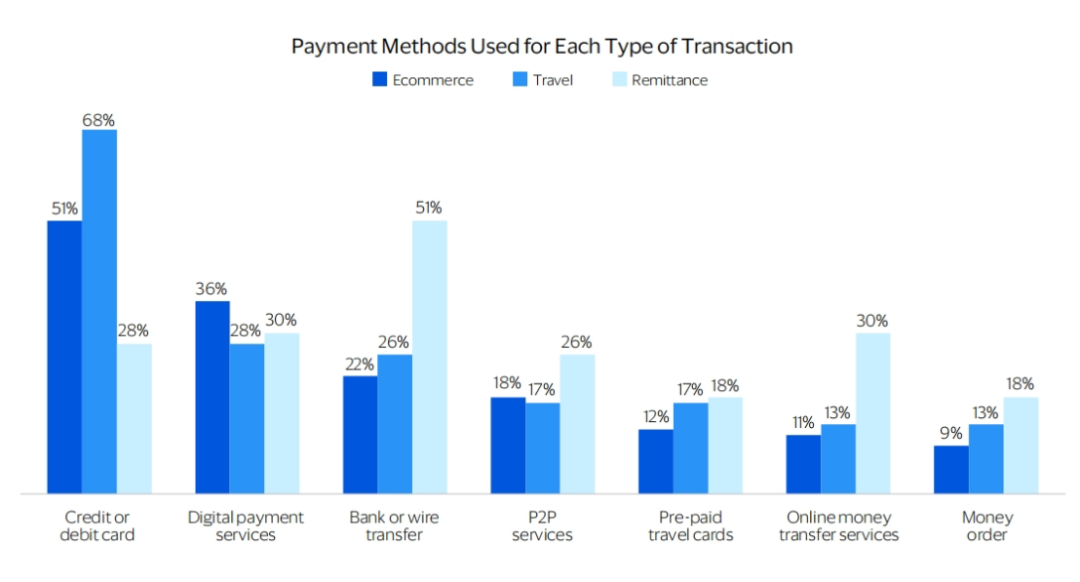
(Unlock the opportunity in cross-border payments, VISA)
3.3 Consumers want more choices
VISA's research shows that in all regions, most consumers want more choices in cross-border payments. A considerable number of consumers are not satisfied with the current cross-border transaction methods available, with one in five consumers saying that they currently do not have enough payment methods to choose from in cross-border transactions. In contrast, one in 12 consumers think there are too many options for cross-border transactions.
Consumers who send money across borders particularly value having more options (76%). This demand is particularly important for consumers in the Philippines (88%) and Mexico (82%), which are also large labor-intensive countries with low local bank penetration.
It is worth noting that even in countries such as Sweden (53%), the United Kingdom (53%) and France (52%), which already have a wealth of payment options, consumers said they would like to have more choices, indicating that the cross-border payment market is still problematic.
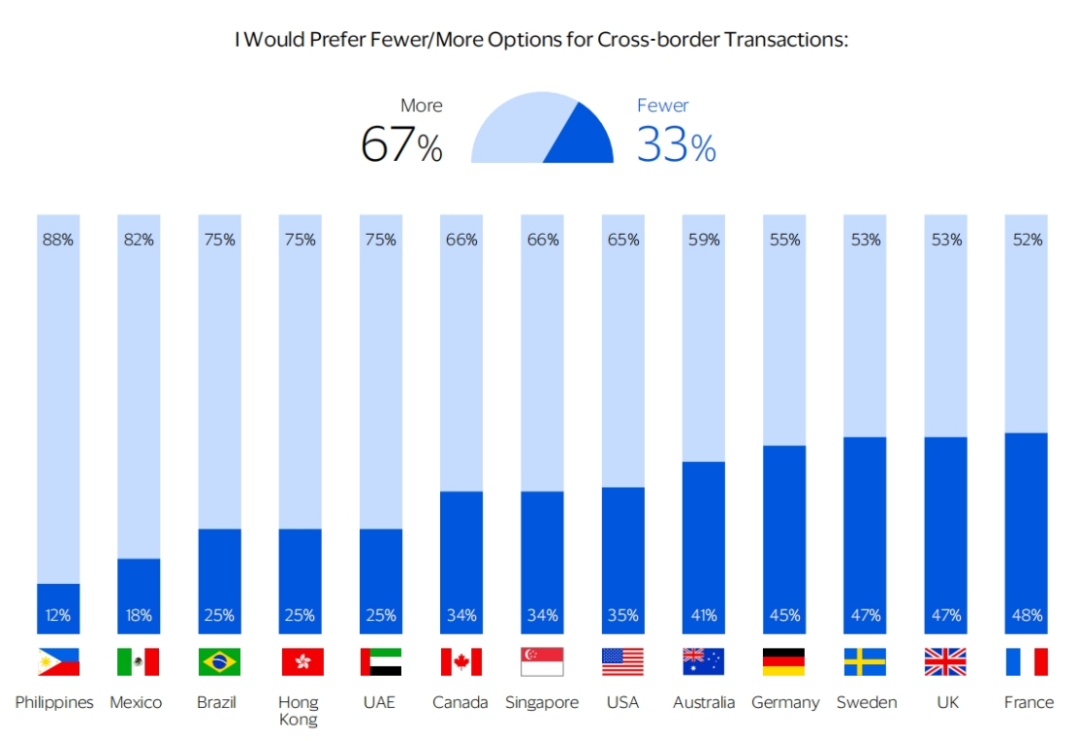
(Unlock the opportunity in cross-border payments, VISA)
More choices mean more competition, especially for banks and fintech companies. It also means that the payment transaction experience is not satisfactory, and consumers will not hesitate to switch to other service providers if they are dissatisfied or need more choices.
As a result, consumers switch between multiple service providers. In key markets for cross-border payments, such as Sweden, Singapore and the UAE, about half of consumers who participate in cross-border payments currently prefer to keep their funds in multiple accounts to gain flexibility in fund transfers. This flexibility provides an impetus for banks and fintech companies to work harder to retain and attract customers by focusing on consumer behaviors, attitudes and needs, prompting them to implement digital app payment methods that are best suited for cross-border transactions.
But with so many choices, and complex fee structures, consumers often feel overwhelmed. So when 71% of consumers say they want more guidance to better understand when and how to use different payment options, it's a clear call to banks and fintech companies: there's a lack of guidance from a trusted source in the market. What they need is security, ease of use, clear guidance, and stable payment habits.
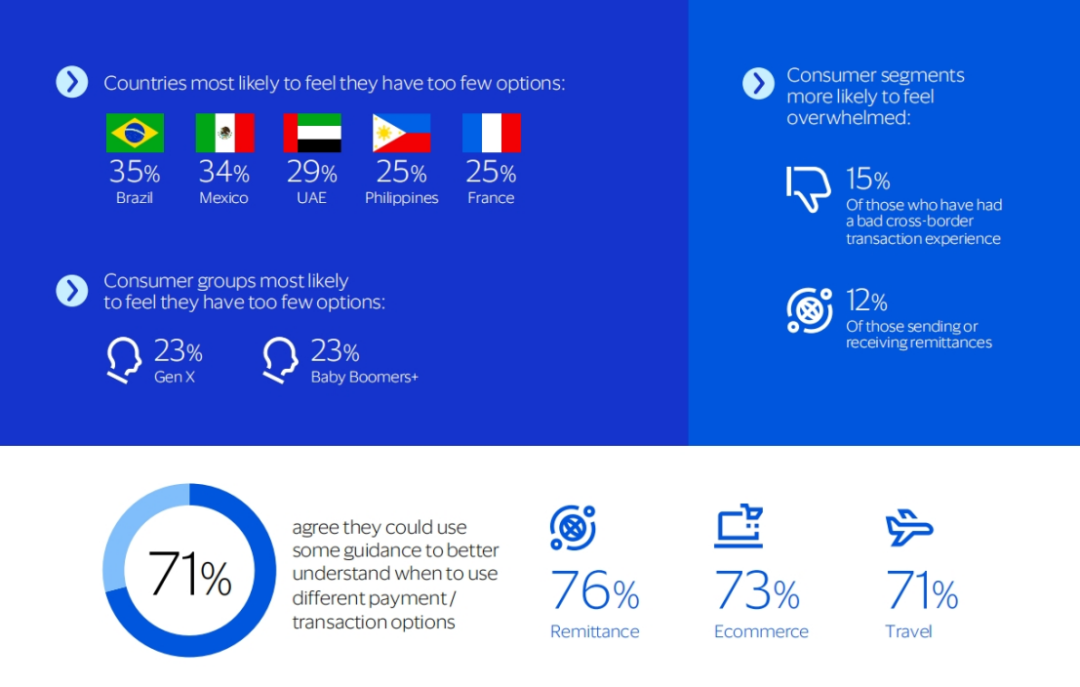
(Unlock the opportunity in cross-border payments, VISA)
Two-thirds of respondents said they like to maintain their routines and stick with payment methods once they find one (66%), while three-fifths said they are currently careful about which tools they use for cross-border transactions (61%).
As people conduct cross-border transactions more frequently, these financial behaviors are becoming habitual. Consumers want easy-to-use services and clear guidance, and many are looking for alternative payment options. This is exactly where fintech companies come in.
3.4 Security is a must, not an option
Consumer trust in payment security is critical for banks and fintech companies. In each region surveyed by VISA, security is always the top factor when choosing a cross-border payment solution. When VISA further analyzes the four most important factors in choosing a cross-border payment method, consumers value security (63%), trust (51%), reliability (49%) and cost (49%) the most.
Across all types of cross-border transactions, security remains a top concern for consumers in all regions and for travel (63%), e-commerce (62%) and remittances (59%).
When analyzing the choice of cross-border payment methods, in addition to the first three considerations, there are also some differences between different markets. For example, for consumers in Mexico, Brazil, the Philippines, Hong Kong, the United Kingdom, Germany and Sweden, the availability and ease of use of payment methods are very important. In Germany, anonymity is one of the top five factors considered by consumers, while in Brazil, consumers said that cost is second only to security and is the second most important consideration when choosing a cross-border payment method.
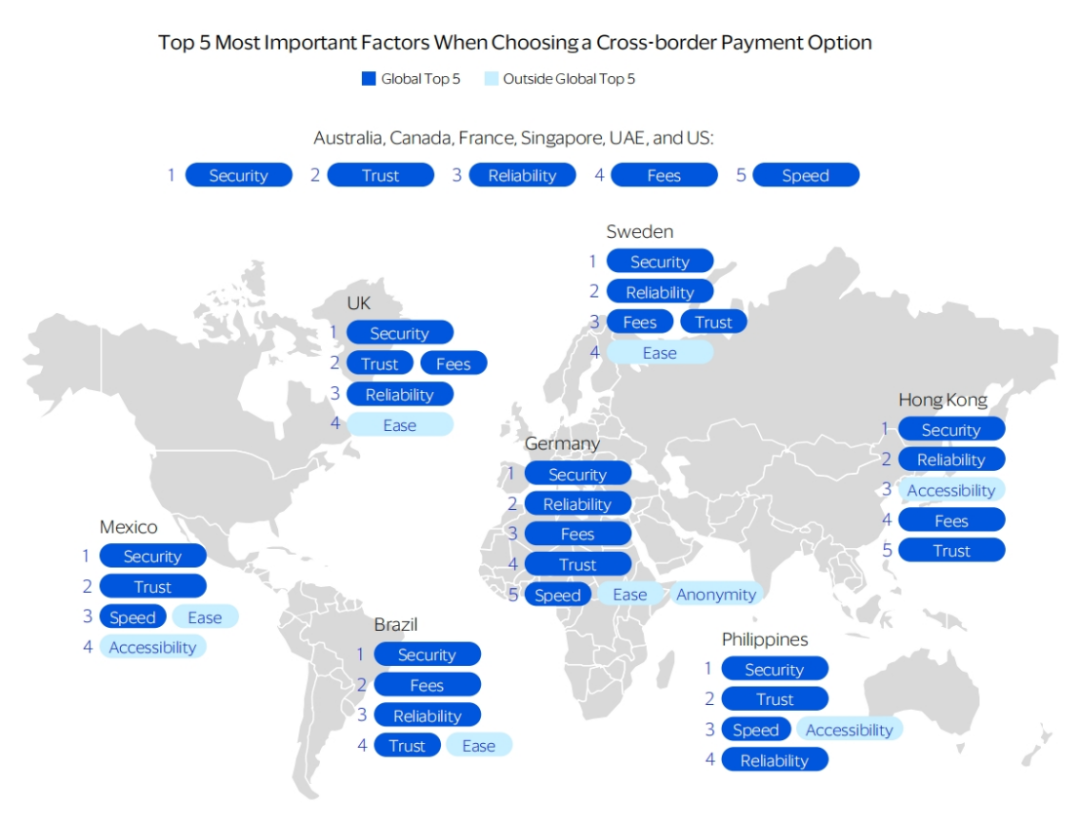
(Unlock the opportunity in cross-border payments, VISA)
One reason why security is so pervasive and important may be due to negative experiences that consumers have experienced, witnessed, or heard about. Negative experiences can range from delays, fraud or scams, lost or stolen funds, transaction errors, fees, card issues, complex processes, unreliable services, or technical failures. These experiences have profound and serious consequences for the people involved.
One in five consumers (21%) have had a negative experience when conducting a cross-border transaction. Additionally, consumers who sent money across borders were more likely to report a negative experience (31%). These groups may be extra cautious about fraud in cross-border transactions.
One UAE consumer described his experience: “…I was sending money to my brother. He needed it urgently, but the payment was delayed for a week and he almost lost his home.” Others reported being double-charged when exchanging currency, being scammed, or having a lack of clear and accessible guidance on how to access their funds. These experiences are extremely disruptive and cause great real harm to consumers.
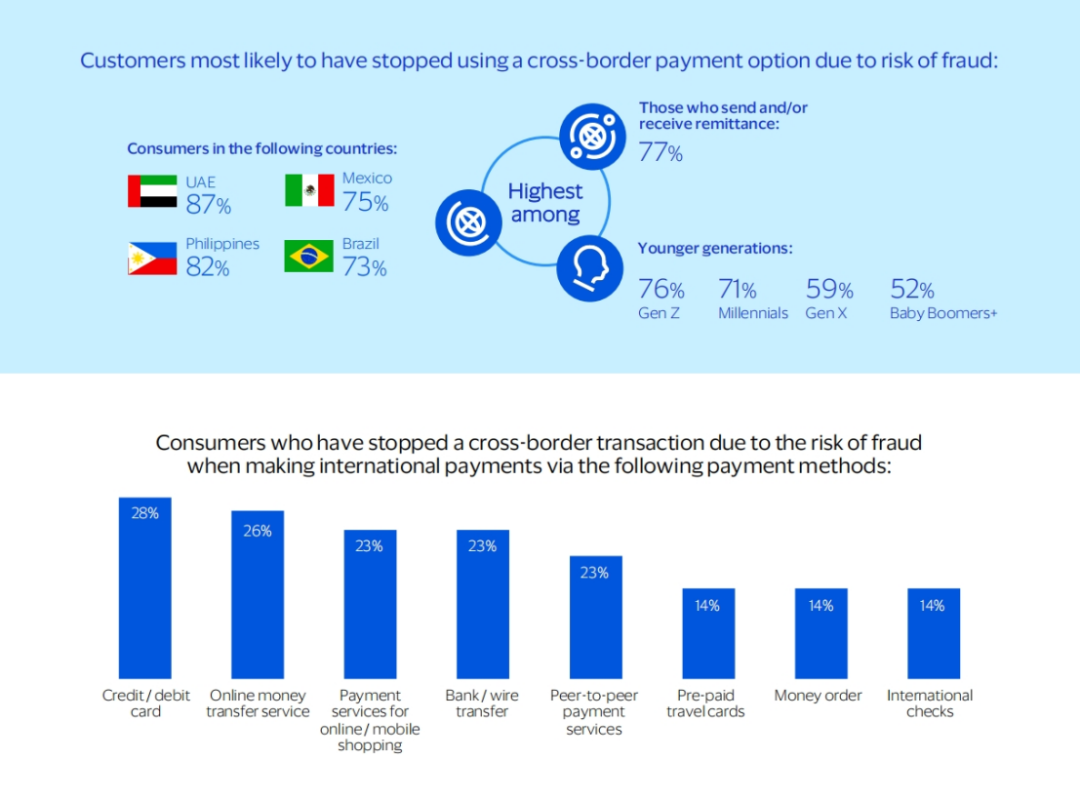
(Unlock the opportunity in cross-border payments, VISA)
Fraud risk is a barrier to using cross-border payments, and the proportion of consumers who stop cross-border transactions due to concerns about fraud risk is quite high. About two-thirds of consumers said that fraud risk has prevented them from using a certain cross-border payment method.
Consumers who send money across borders, younger generations, and consumers from the UAE, Philippines, Mexico, and Brazil are more likely to stop using a payment method due to concerns about fraud. 76% of Gen Z and 71% of Millennials, respectively, have interrupted a transaction due to suspicion of fraud, compared to 52% of Baby Boomers and older. While older generations have traditionally built a high level of trust in traditional banks, younger generations are more casual in their choice of cross-border payment service providers, some of which may be newer market players that have not yet built enough trust.
4. VISA’s cross-border payment solution – VISA Direct
With the rise of financial technology, the money transfer business previously dominated by banks is no longer limited to a specific place, but can be used anywhere with an Internet connection. In the past, cross-border payment methods were mainly dominated by bank remittances and card payments. As a global leader in digital payment technology, VISA is also exploring how to integrate with VISA's existing card organization bank network through digital means to provide consumers with a more convenient cross-border payment experience - VISA Direct.
4.1 What is VISA Direct
VISA Direct is a payment platform that enables near real-time domestic and international fund transfers. The platform uses the processing power of the VISANet global network to enable payment initiators to "push" funds directly to the recipient's bank account or VISA card in a secure and convenient manner within 30 minutes through acquiring institutions.
Users can use VISA Direct to send money to more than 2 billion VISA cardholders and account holders worldwide (Account To Account, A2 A), and transfer funds to eligible bank cards, deposit accounts and digital wallets in more than 190 countries and regions. VISA Direct supports a variety of uses, including person-to-person (P2 P), business-to-consumer (B2 C) and business-to-business (B2 B) payments.
The VISA Direct solution is supported by more than 500 VISA partners, including acquirers, banks, fintech companies and other partners. Through this solution, VISA's global customers and partners can connect to VISA Direct through a single access point to push payments to eligible VISA cards or accounts, thereby enabling domestic or cross-border payments.
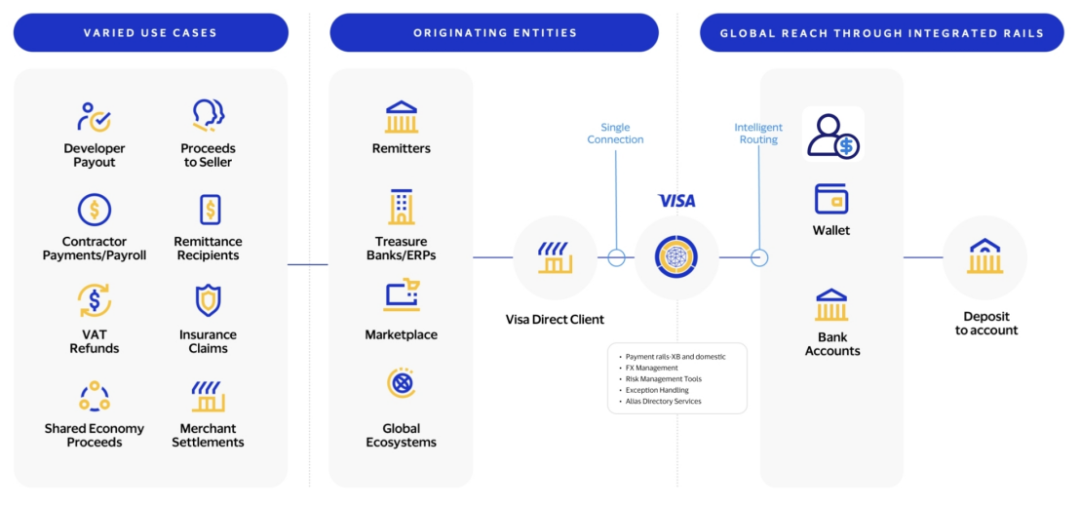
(VISA Direct Account and Wallet)
Although this feature is currently only available for some VISA cards, and acceptance depends on the cooperation of the cardholder's institution, its scope of application is continuing to expand. In fiscal year 2023, VISA Direct processed more than 7.5 billion transactions in more than 2,800 projects worldwide, supporting more than 65 usage scenarios. Recently in March 2025, VISA officials stated that VISA Direct's cross-border transactions increased by 50% year-on-year, P2P transactions increased by 80% year-on-year, and the annual compound growth rate of transactions reached 40%.
In terms of cross-border payments, the core of VISA Direct is: 1) using its established efficient global VISANet card organization network to replace the old SWIFT agency bank network system; 2) connecting to numerous digital partners through the digital VISA API; 3) connecting the bank account system and the VISA card account system, and providing one-stop access.
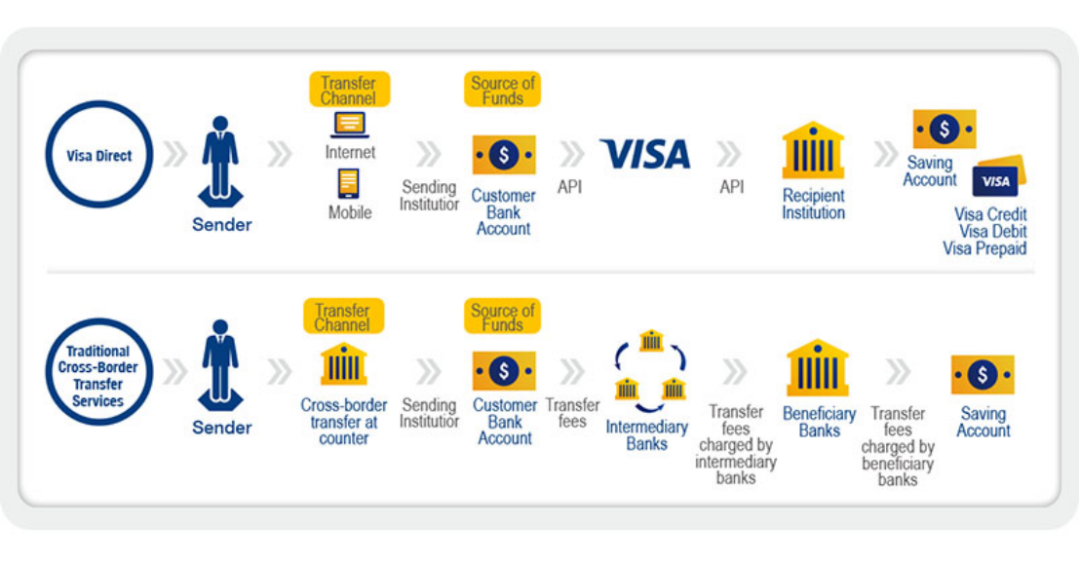
(Simplify how you send money abroad)
4.2 What are the advantages of VISADirect?
VISA Greater China President Shirley Yu said: "As a network of networks, VISA is the driving force behind the transformation of cross-border capital flows, connecting the world through innovative technologies. From banks to card issuers to fintech companies, all types of customers can connect to VISA Direct through a single access point to create cross-border payment tools that provide consumers and businesses with fast, secure and reliable global capital flows."
This type of real-time cross-border payment holds huge opportunities. Data shows that companies that use the global real-time payment network for cross-border transactions can increase transaction volume by about 15% each year and increase profits when entering new markets. In addition, companies are expected to reduce customer churn by up to 60% while improving payment reliability and security.
VISA can provide solutions. VISA Direct enables five major advantages of cross-border payments:
A. Global coverage
VISA Direct provides a single access point to more than 8.5 billion terminal devices. Its real-time cross-border payment solution allows users to easily access billions of bank cards, network terminals, accounts and digital wallets around the world through a single connection.
B. Simplify compliance
VISA Direct provides compliance support to users through its strong partner ecosystem and VISA Network. When using the card-based network, more and more peer-to-peer transactions are possible. When the sender and the recipient use the same bank service, the payment chain will be significantly simplified; and when payments are made through digital wallets, this process will be further optimized.
C.Continuous innovation
With over 60 years of industry experience, VISA Direct is committed to driving the continuous advancement of payment technology by innovating to create future-oriented payment capabilities.
D. Improve transparency
VISA Direct is helping financial institutions and other payment providers gain greater transparency into foreign exchange rates. VISA generates foreign exchange rates using multiple existing market indicators, including data from top market data providers, pricing and liquidity data from foreign exchange trading platforms, and central bank pricing indicators.
E. Cost-effectiveness advantage
VISA Direct modernizes businesses’ cross-border payment capabilities, enabling them to leverage VISA’s industry-leading infrastructure without having to make costly investments in their own infrastructure.
In an increasingly interconnected global economy, the ability to quickly and securely move funds across borders is critical. VISA Direct offers a comprehensive solution based on the card association network to help businesses streamline cross-border transaction processes, reduce costs and improve the customer experience.
But as mentioned before, VISA Direct is still an optimization of an old system, just like aerial refueling, rather than sailing to the starry sea in space.
5. Web3 Payment Solutions
Just like the essential attributes (value scale) and core functions (medium of exchange) of currency remain unchanged, despite the carriers or forms of currency such as shells, chips, cash, deposits, electronic money, stablecoins, etc., the essence of Web3 payment remains unchanged - the transfer of value (Exchange of Value). What needs to be changed is the service mode of banks, payment institutions, etc., and what needs to be considered is how to provide better financial payment services in a distributed, digital, and space-time scenario.
Web3 payment is a new payment method based on blockchain technology and digital currency. Compared with traditional payment systems, Web3 payment has the following characteristics:
- Instant settlement: Blockchain technology can achieve instant transaction settlement on a global scale.
- Reduced costs: Web3 payments can significantly reduce transaction costs and management fees by eliminating intermediaries. Global accessibility: Anyone with an internet connection can make payment transactions at any time, especially in areas that are not covered by the traditional financial system (Under-banked and Unbanked).
- Decentralization: Web3 payments enable permissionless access and asset ownership through decentralized finance (DeFi).
- Programmability and interoperability: Combined with smart contract technology, Web3 payments can create more financial derivative services such as lending and financial management.
- Enhanced transparency and openness: The public and transparent nature of blockchain increases visibility into the flow of funds and simplifies cross-border payment processes.
Overall, Web3 payment is not only a new payment method, it also provides a more open, efficient and innovative financial payment solution through the combination of blockchain technology and digital currency.
This can be an embedded solution, just like Gate Pay helps embed the digital currency payment Pay with Crypto option in traditional payment gateways. It can also be a cost-cutting and efficiency-enhancing solution based on blockchain and stablecoins, such as the case of Stripe's acquisition of Bridge. It can also be a new innovative financial form based on the blockchain settlement layer, taking into account both on-chain and off-chain, just like the Morph Black product that MorphPay aims to create.
In fact, behind the payment method, the most significant change brought by Web3 payment is the change in the accounting method - blockchain is an open and transparent global public ledger. The current Web3 transformation of the SWIFT network and card organization network is also a process of gradually migrating to the blockchain settlement network.
5.1 Web3 transformation of cross-border e-commerce
As previously analyzed, cross-border e-commerce payment scenarios are more likely to be consumers in their own country, using the payment gateway of overseas e-commerce platforms to make consumer payments. For cross-border e-commerce, Web3 payment can intervene in two aspects:
- Embed a digital currency payment (Pay With Crypto) option in payment gateways or digital wallets to facilitate consumption by people who pay with digital currency;
- Use blockchain as a settlement network to optimize the settlement of funds between users and merchants, so as to reduce the payment fees of users and merchants and improve the capital utilization efficiency of merchants.
Although we can see that Web3 payment can indeed bring benefits to cross-border e-commerce payments, a very realistic problem, and one that has been discussed by the industry, is how to achieve Mass Adoption of cryptocurrency - how to let users own Crypto, and how to let merchants accept Crypto.
5.1.1 Bridge——Stablecoin infrastructure acquired by Stripe for $1.1 billion
Stripe, one of the three largest payment giants in the United States, acquired Bridge.xyz, a stablecoin infrastructure company that was only established two years ago, for US$1.1 billion in October 2024, creating the largest acquisition deal in the crypto industry. Bridge is a stablecoin API infrastructure that provides software tools that help businesses accept stablecoin payments.
Bridge's main product is the Orchestration API, which is an API that integrates stablecoin collection and payment into an enterprise's existing business. After integration, Bridge will handle all complex compliance, regulatory and technical issues.
Through the Orchestration API, combined with Bridge's own 1) stablecoin cross-chain transactions, 2) fiat currency/cryptocurrency deposit and withdrawal acceptance, and 3) virtual bank accounts, it can help users transfer funds globally in minutes, seamlessly send stablecoin payments, convert local fiat currencies into stablecoins, and provide global consumers and businesses with US dollar and euro accounts, allowing users to save and spend in US dollars and euros.
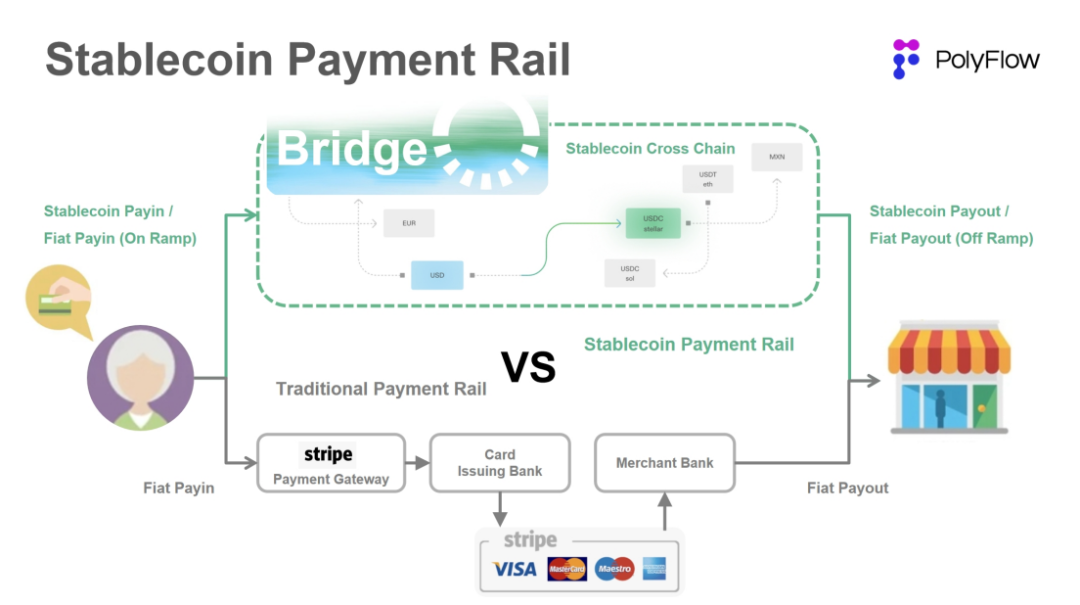
(PolyFlow Insights: The Next Step Beyond Stripe & Bridge is PayFi)
For Stripe, one of the world's largest payment service providers, the emergence of Bridge can, on the one hand, help the implementation of Stripe's Pay With Crypto strategy, so that more and more existing businesses will be settled in stablecoins, in order to achieve internal cost reduction and efficiency improvement, and a smooth and seamless user product experience; on the other hand, Stripe can use Bridge to build a stablecoin payment path outside the original bank, card organization, and SWIFT payment system, expand beyond its ecosystem, and be compatible with DeFi.
Therefore, after combining with Bridge, Stripe's network effect is no longer limited to its ecosystem, but the entire stablecoin market. Similarly, the PayFi ecosystem built in combination with DeFi can break through the geographical limitations of traditional financial services and realize the free flow of value and financial inclusion for global users. This is also the direction that Paypal, which has issued stablecoins, is working hard to achieve.
Bridge's official announcement stated: "The two parties will work together to accelerate the adoption and practicality of tokenized dollars, making it easier for everyone in the world to transfer, store and spend money. Through many practical cases, it has been proved that stablecoins can become the core global capital flow infrastructure and represent a new payment platform. This is not because consumers or businesses inherently want "cryptocurrency", but because stablecoins solve key financial problems."
5.1.2 Gate Pay——Starting with Payment from Exchanges
As an industry-leading B2B cryptocurrency payment solution, Gate Pay provides a one-stop cryptocurrency acquisition, issuance, and fiat currency deposit and withdrawal service. It also provides white label payment gateways and other customized solutions.
In the early days of exchange development, we can see exchanges such as Binance, Crypto.com, and Gate.io launching closed-loop trading functions based on their own ecosystems, such as Gate.io's Gate Life merchant mall, gift card center, etc. (supporting merchants to settle in and users to pay via cryptocurrency) and Gate.io's Crypto Payment Card. The core essence of exchange payment 1.0 is 2 C business, to compete for users, to meet the actual consumption needs of the exchange's large-scale C-end users, to maintain user retention, and to promote user activity and loyalty through some incentives.
As the industry develops, Gate Pay abstracts the payment capabilities of exchanges to form a set of external 2 B crypto payment solutions. Any merchant or institution can use API or white label to access all Gate Pay product capabilities. Merchants can customize their own front-end and display, and reach their own merchant network with their own brand. Gate Pay is willing to be an infrastructure builder and solution provider to promote large-scale application scenarios such as cryptocurrency payments, both in front of and behind the scenes.
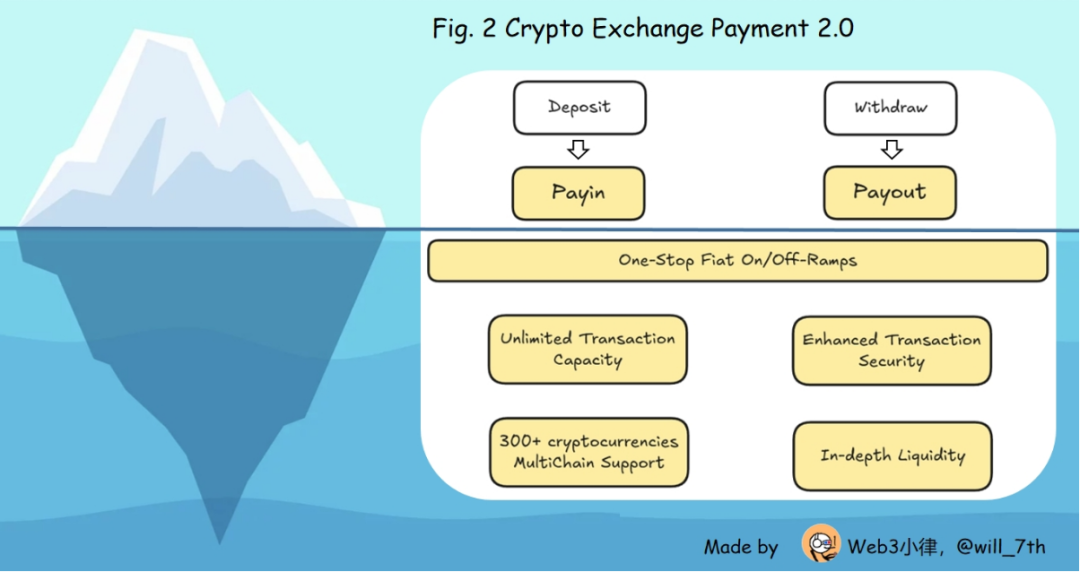
As Feng, the person in charge of Gate Pay, said: "Exchange payments have evolved from the initial Crypto Payment Card to the internal exchange marketplace, and then to the payment of QR codes generated between internal ecosystems. In essence, these are 2C businesses, and most exchange payments do not have 2B capabilities. In fact, it was mentioned before that the greater purpose of exchange payment 1.0 is to serve the existing users of the exchange and provide user retention and loyalty.
The greater purpose of Exchange Payment 2.0 is to serve users outside the exchange. On the one hand, it can make use of the mature modules that the exchange has already built to better expand its 2B business. On the other hand, it can also indirectly convert some 2C users and maximize the advantages of both 2B2C ends. "
5.2 Web3 transformation for cross-border travel
As mentioned above, the payment scenarios for cross-border travel are more likely to be: overseas offline payments, through debit/credit cards or digital wallet App payment platform scanning codes. Web3 payment is more embedded in digital wallets, and payments are made to merchants in a form similar to QR code payment. Let's first look at the role of Web3 payment from the perspective of online cross-border travel website booking, and then from the perspective of offline consumption.
5.2.1 Travala – Leading Cryptocurrency Travel Service Provider
Travala.com is a leading cryptocurrency-native travel booking service provider with 2.2 million+ listings in 230 countries, 400,000+ activities, and 600+ airlines. Travala.com offers a seamless travel booking experience that incorporates next-generation blockchain technology, tokenized incentives, and a “Best Price Guarantee” for accommodations and activities.
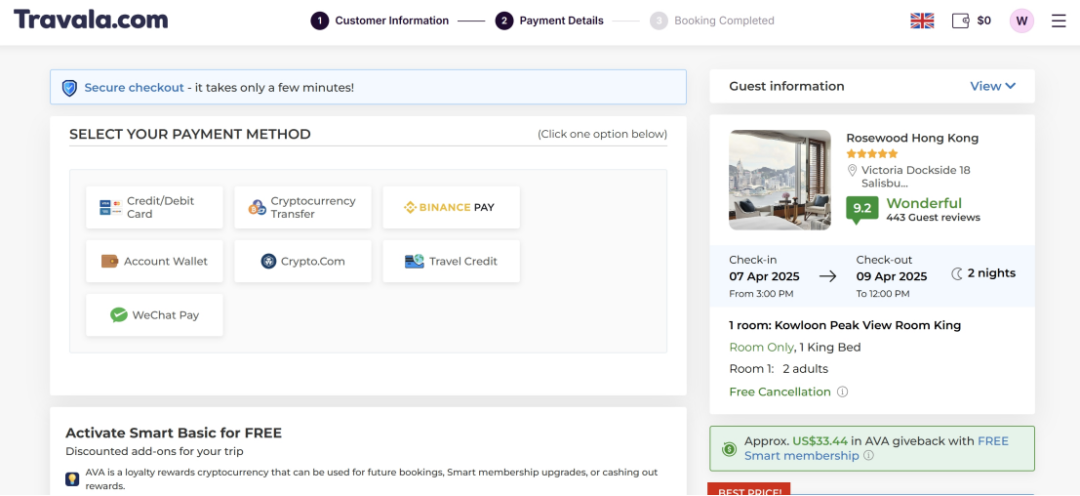
(www.travala.com/ava)
In addition to traditional payment methods, Travala.com also supports more than 100 leading cryptocurrencies for payment. Travelers can book with cryptocurrencies and receive up to 10% Bitcoin or AVA back, discounts, AVA token rewards, etc. through the AVA program. The AVA program provides discounts and loyalty rewards for eligible bookings made on Travala.com, and even greater benefits for members at higher membership levels.
AVA is a loyalty rewards token that is more flexible than traditional points. Travelers can use AVA to book future travel on Travala.com, upgrade their AVA Smart Program membership tier, or spend AVA on other online platforms that accept AVA.
Travala.com was founded by a group of experienced experts in the travel, fintech and blockchain industries, with a mission to promote the adoption of cryptocurrency through travel. Travala.com's vision is to combine travel booking with the ideas of decentralized technology: promote accessibility to anyone in the world; provide censorship-resistant and peer-to-peer transactions; and create a travel ecosystem governed by users.
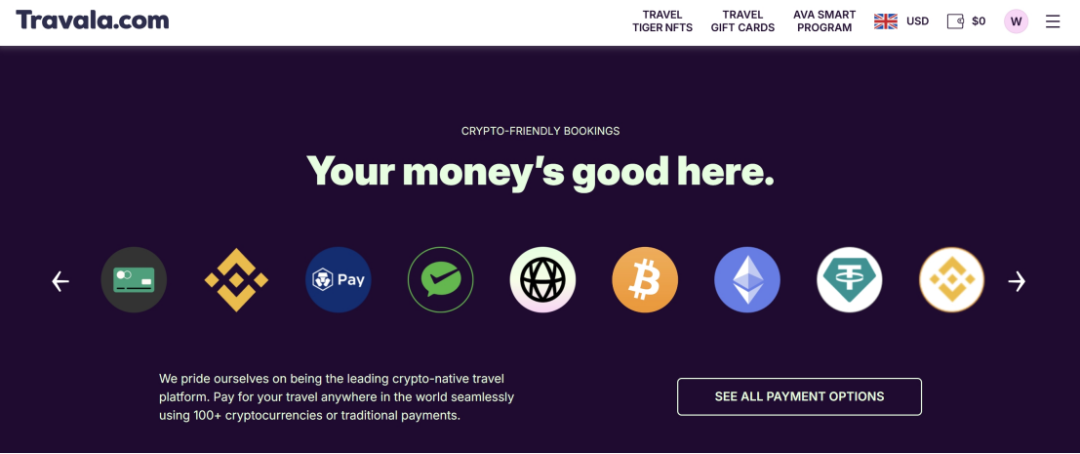
(www.travala.com/ava)
Although as mentioned above, Travala.com has included various mission, vision and values of Web3 in its official website, we can see the essence through the phenomenon:
- The essence of Travala.com is an OTA travel platform that has added a crypto payment option. After receiving the customer's cryptocurrencies, it will withdraw the money to legal currency and finally settle with the merchant. From this perspective, it only promotes the popularization of digital currency payment and access to the crypto customer group;
- By using cryptocurrency and making settlements through blockchain, the platform and merchants can save a lot of transaction fees. For example, the standard transaction fee charged by Stripe Gateway for fiat currency payment is 2.9% + $0.30 per transaction, international cards are charged an additional + 1.5%, and currency conversion involves + 1%. Then, the fees saved by both the platform and the merchant can be returned to the users to achieve the "best price guarantee";
- The travel platform's loyalty program is run by the AVA token economy. Generally speaking, the points of hotel and airline loyalty programs are liabilities of the company, but the benefit of having a token economy is that it is an asset of the company, and the cost of the project party's initial investment in acquiring the asset is "0". Once the token economy is running, it will be able to achieve global reach.
5.2.2 Web3 Payment in Offline Street Corner Café
Low-value transactions are a potential opportunity for Web3 payments, especially face-to-face offline transactions with low fraud, such as transactions conducted in restaurants, coffee shops, or corner stores. Due to low profit margins, these businesses are cost-sensitive, so the 15-cent transaction fee charged by some payment solutions may have a big impact on their profitability.
For every $2 spent by customers on coffee, only $1.70 to $1.80 goes to the coffee shop, and the remaining nearly 15% goes to the credit card company. These high fees are only to facilitate transactions, and the credit card here has only one purpose, which is to facilitate the payer.
Neither the consumer nor the store needs additional features to justify the transaction: consumers don’t need fraud protection (they’re just getting a cup of coffee) or loans ($2 for the coffee), and coffee shops have limited compliance and bank integration needs (they typically use comprehensive restaurant management software or none at all). So if there’s a cheap, reliable alternative, these merchants will use it.
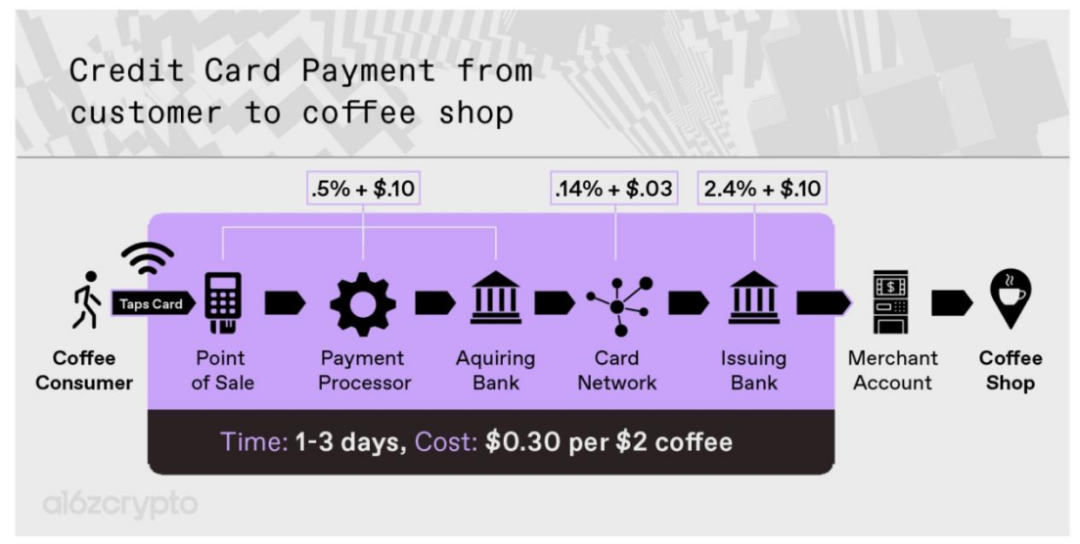
(How stablecoins will eat payments, and what happens next, a16z)
Then offline Web3 payment in the form of QR code scanning can solve the above pain points. Settlement can be made directly through blockchain and stablecoins, and the high credit card fees can be left behind. Merchants can obtain greater profit margins and receive payment instantly. Why not do it?
5.3 Web3 transformation of cross-border remittances
Global remittances are the lifeblood of many families around the world, and while over the past few years we have seen a wave of new financial technology companies (FinTechs) dedicated to facilitating and streamlining digital payments, traditional remittance channels have long been plagued by high fees, slow transfer times, and cumbersome processes.
According to statistics from international banks, globally, the average cost of remittances is 6.62% of the remittance amount.
Cross-border remittances can take up to five business days to settle. The Bank for International Settlements (BIS) reports that delays in the clearing and settlement process cost the global economy billions of dollars each year due to liquidity inefficiencies.
As a result, many consumers are turning to cryptocurrencies as a payment option to avoid the pain points of cross-border remittances, such as long processing times and high transfer fees. PYMNTS research found that a significant portion of consumers (24%) see the option to receive funds in cryptocurrency as one of the main motivations for choosing a payment service provider (PSP). For solution providers, there is a huge opportunity to provide alternatives to traditional remittance payment methods, such as blockchain payment options.
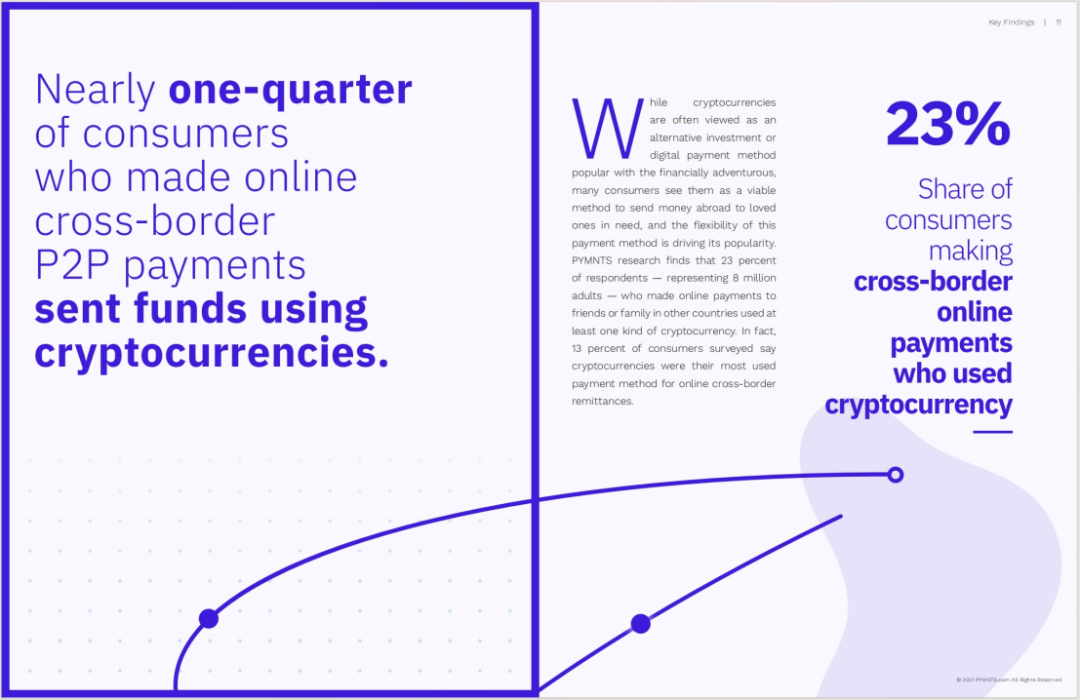
(The Digital Currency Shift: The Cross-Border Remittances Report, PYMNTS)
A 2021 study by PYMNTS and the Stellar Development Foundation shows that while cryptocurrencies are often viewed as an alternative investment or digital payment method, many consumers see them as a viable option. Among respondents who paid friends or family online in other countries, 23% used at least one cryptocurrency. In fact, 13% of consumers surveyed said that cryptocurrency is their most common payment method for online cross-border remittances. The PYMNTS study found that consumers who adopt cryptocurrencies also tend to use other cross-border payment transfer methods to eliminate friction in the payment process. Consumers who use cryptocurrency to send cross-border remittances are more likely to send them directly into a mobile wallet (46%).
As the cross-border payments market continues to grow, payment service providers are under pressure to reduce remittance fees and address delays. Many consumers send remittances due to urgent financial needs of friends or family, so they prefer solutions that can complete payments quickly and securely.
5.3.1 BCRemit——Using USDC to Solve the Barriers of Cross-Border Remittances for Philippine Workers
BCRemit is trying to change that for migrant workers, especially Filipino workers working in the UK and the US. By integrating Circle’s USDC, BCRemit is redefining the remittance experience for its users – making it faster, cheaper, and more convenient than ever before, solving many of the challenges faced by traditional remittances and providing users with a more efficient and low-cost remittance experience.
Oliver Calma, the founder of BCRemit, was once an overseas worker and is well aware of the high costs and complex processes of traditional remittances. Through USDC, BCRemit can achieve instant 24/7/365 transactions, and can quickly process remittances even on weekends and holidays, meeting users' needs to transfer money at any time.
Compared to traditional banks and remittance companies, BCRemit’s cross-border remittance fee is only 1%, which is 90% lower than the target set by the United Nations Sustainable Development Goals to reduce remittance costs to below 3% by 2030.
At the same time, USDC's fast settlement capability reduces the large amount of capital reserves required by BCRemit to pre-fund accounts in target countries, reduces liquidity constraints and interest expenses, optimizes its working capital, makes its financial position healthier, and enables it to invest more funds in services and growth.
BCRemit seamlessly integrates USDC into its backend operations, allowing users to easily transfer money without having to directly contact cryptocurrencies or complicated processes when using the BCRemit application. This user-friendly design makes it easy for even users with weaker technical backgrounds to use the service.
BCRemit also promotes broader financial inclusion by providing multiple ways to receive money, including bank accounts, e-wallet top-ups, and cash pickup options at over 17,000 locations in the Philippines, ensuring that even unbanked recipients can easily access funds. By reducing costs and simplifying the remittance process, BCRemit enables overseas workers to support their families more effectively and improve their quality of life.
5.3.2 MoneyGram - Opening up the "last mile"
MoneyGram International (MoneyGram) has successfully combined digital assets with traditional cash services through its innovative MoneyGram Access™ product, solving the pain points of digital assets in the "last mile" delivery. MoneyGram Access is supported by the Stellar blockchain and leverages the efficiency and low cost of the Stellar network to provide users with seamless conversion between cash and cryptocurrency.
Specifically, MoneyGram Access allows users to exchange cash for USDC (a stablecoin) at MoneyGram's global outlets, allowing users to use their funds in an unprecedented way to protect their national currencies from depreciation. At the same time, users can also send funds quickly and securely to any region in the world that supports the service through the blockchain network. Whenever they need funds in physical form, users can withdraw local currency through their USDC at participating MoneyGram outlets, thereby achieving seamless integration of digital assets with the traditional cash economy.
This service is particularly targeted at informal economic participants who do not have access to bank accounts or credit cards, enabling them to participate in the storage and transfer of digital assets in cash. In addition, MoneyGram has also joined hands with partners such as TruBit to further expand the coverage of its digital asset services. For example, in Latin America, MoneyGram has partnered with TruBit to introduce the MoneyGram Access service to core markets such as Mexico, Argentina, Brazil and Colombia to meet the region's demand for efficient cross-border payments.
By integrating Stellar blockchain technology and USDC stablecoin, MoneyGram not only improves the speed and security of cross-border remittances, but also reduces transaction costs and promotes financial inclusion. This innovative model provides a successful example for the global payment industry to combine traditional financial services with emerging digital technologies.
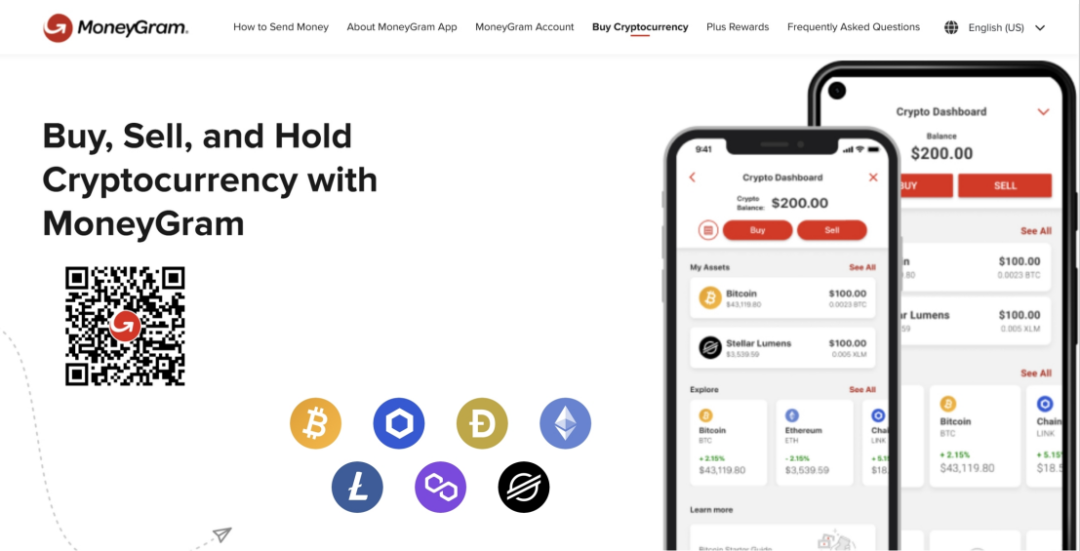
(moneygram.app/buy-cryptocurrency)
BCRemit's case starts from a single-point scenario (remittance scenario for overseas Filipino workers). Through the combination of blockchain technology and stablecoins, it has achieved a significant reduction in user remittance costs and ensured the timeliness of fund transfers. Although the circulation of stablecoins on the chain is already very smooth, it is still necessary to open up the "last mile" from digital currency to legal currency. BCRemit's solution provides options including bank accounts, e-wallet top-ups, and cash withdrawals at more than 17,000 locations in the Philippines, while MoneyGram directly connects digital currencies to its original cross-border remittance business and connects its 350,000+ agent currency exchange outlets around the world.
6. Web3 Payments, More Than Just Payments
Many of the cases mentioned above are based on the Web3 transformation of traditional financial payment methods. However, if we look at it from a broader perspective, is it possible to use blockchain and digital currency to build a Web3 payment path for consumers that is outside the original bank, card organization, and SWIFT payment system, and is also compatible with DeFi's better solution?
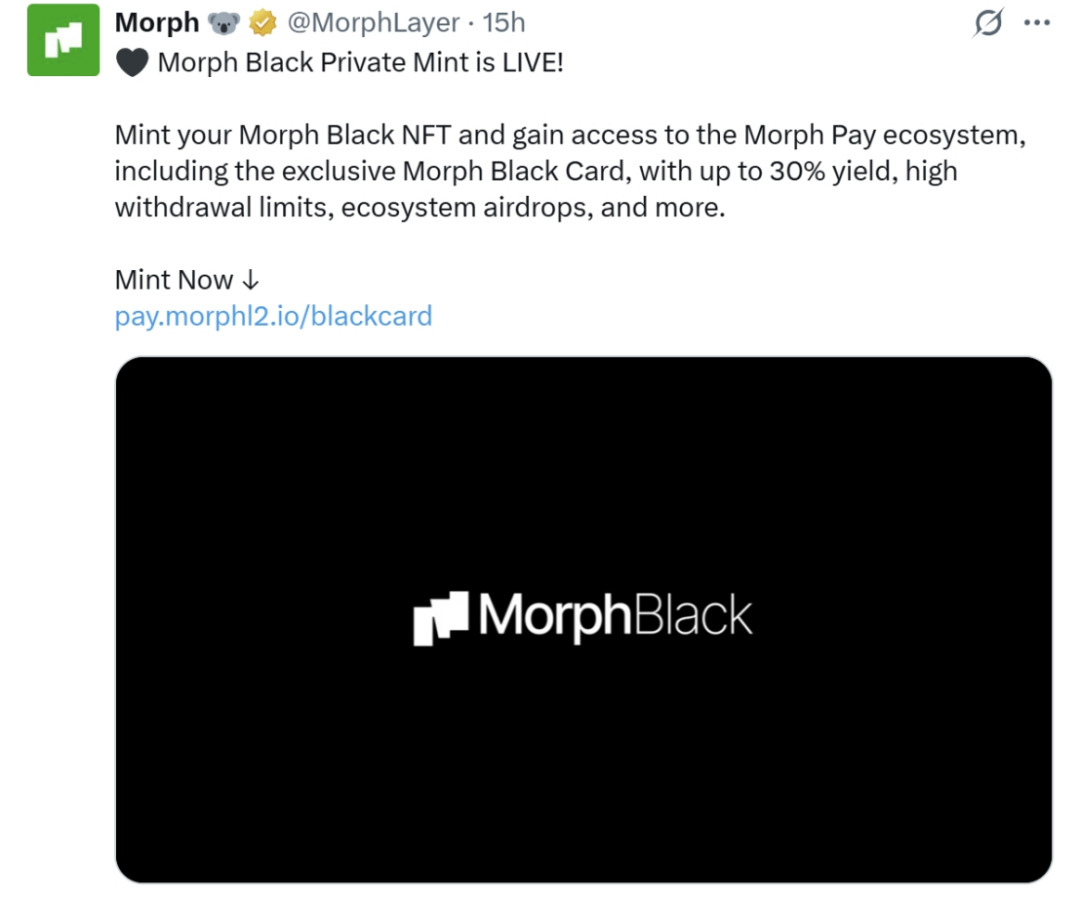
(x.com/MorphLayer)
Morph Pay is using the most cutting-edge Web3 technology to revolutionize digital payments. We have seen the direction in Morph Pay's recent launch of Morph Black, known as "the first black card for young people", which takes into account multiple solutions that consumers need in cross-border payments:
A. Blockchain as a settlement layer. Morph Pay uses Morph, a global consumer-grade public blockchain dedicated to promoting the large-scale popularization of Web3, as a settlement layer to achieve instant settlement, 24/7/365, low transaction fees, programmability and interoperability of consumer payments.
B.CeFi compatibility. Morph Pay can also provide consumers with convenient conversion from digital currency to legal currency and flexible banking services through its partner licensed financial institutions.
C. Consumer payment. Whether the backend is connected to a VISA/Mastercard debit card or a digital wallet payment scenario, it can provide consumers with a better solution to replace the original old payment methods.
The above three points are actually what Web3 payment solutions must achieve, but native Web3 payment solutions can provide much more than these:
D. DeFi compatibility. As a payment product launched by the consumer-grade public chain Morph, Morph Pay can not only create a one-stop DeFi income aggregation solution for consumers, supporting an annualized yield of up to 30% for crypto asset deposits, but also support innovative operations of smart contracts, thereby building scenarios that are difficult to achieve with traditional financial payments. For example, DeFi income can be directly used for daily payments, achieving a seamless connection between asset appreciation and payment scenarios, and evolving the previous Buy Now Pay Later to Buy Now Pay Never.
E. Ecosystem governance empowerment. On-chain: Users will be able to participate in exclusive ecosystem airdrops and incentive activities provided by Morph and its ecosystem partners; Off-chain: Provide consumer cashback, Aspire travel concierge services, industry summits and other benefits to further provide users with utility.
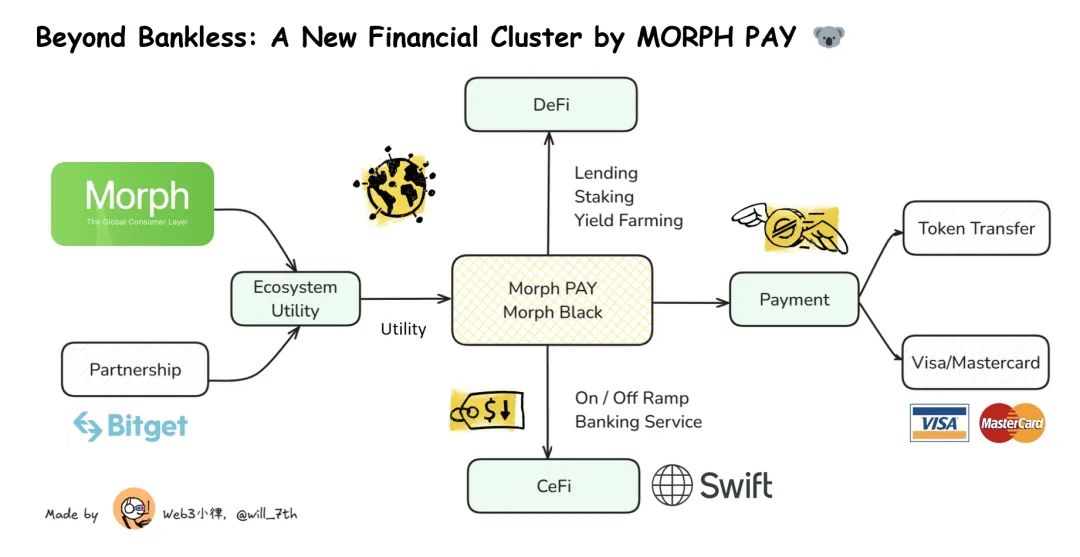
Through the case of Morph Pay, we can see that solutions based on blockchain and digital currency are no longer limited to a single product and a single scenario. This kind of on-chain composability has been able to build a new type of financial service complex, covering payment, savings and financial management, lending, remittance transfer, and ecological governance. This is not just about digital currency, but also legal currency.
We used to say we needed to be bankless, but now it seems clear that we have already broken through the boundaries of bankless.
7. Final Thoughts
Finally, I would like to end with a statement from Gate Pay Feng that I agree with very much:
“In the traditional Internet field, payment is the most sticky application scenario: everyone may not have brokerage or trading apps on their mobile phones, but they must have multiple payment apps, and the same applies to Web3. At present, the vast majority of Web3 audiences or users are attracted to the market by the trading attributes and money-making effects of cryptocurrencies, but even so, the number of people who own cryptocurrencies still accounts for less than 5% of all Internet users, and the penetration rate is extremely low. If one day, when the crypto market or Web3 can reach more than 90% of Internet users, then this scenario will definitely not be DeFi and Crypto Trading, but Payment.”
















